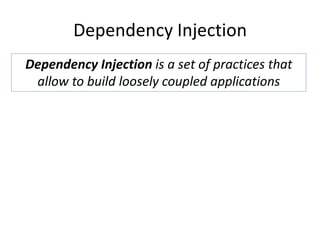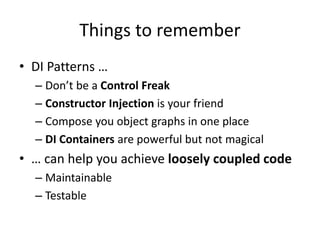The document discusses dependency injection (DI) as a set of practices for building loosely coupled applications, emphasizing its benefits such as easier maintenance and testability. It explores common patterns like constructor injection and highlights the importance of composing object graphs in a single location. Additionally, it addresses challenges and anti-patterns in implementing DI effectively, encouraging the use of interfaces and DI containers to improve code quality.










![Starting from scratch
public class AccountController : BaseController
{
// GET: Account
[HttpGet]
public ActionResult Index()
{
var userId = this.User.AsClaimsPrincipal().UserId();
using (var context = new BankingDbContext())
{
var accounts = context.Accounts
.Where(a => a.CustomerId == userId)
.OrderBy(a => a.Title).ToList();
return View(accounts);
}
}
[HttpPost]
public ActionResult TransferPost(int from, int to, decimal amount)
{
var userId = this.User.AsClaimsPrincipal().UserId();
using (var context = new BankingDbContext())
{
var accountFrom = context.Accounts
.Single(a => a.CustomerId == userId && a.Id == from);
var accountTo = context.Accounts
.Single(a => a.CustomerId == userId && a.Id == to);
accountFrom.Balance -= amount;
accountTo.Balance += amount;
context.SaveChanges();
return RedirectToAction("Index");
}
}
data
business
presentation](https://image.slidesharecdn.com/dependencyinjection-therightway-141024062523-conversion-gate02/85/Dependency-injection-the-right-way-11-320.jpg)


![public class AccountController : BaseController
public Account GetAccountForCustomer(int customerId, int accountId)
{
// GET: Account
[HttpGet]
public ActionResult Index()
{
var userId = this.User.AsClaimsPrincipal().UserId();
public void Transfer(int userId, int fromAccountId, int toAccountId, decimal amountToTransfer
var userAccountService = new UserAccountService();
var accounts = userAccountService.GetAccountsForCustomer(userId);
return View(ToViewModel(accounts));
}
[HttpPost]
public ActionResult TransferPost(int from, int to, decimal amount)
{
var userId = this.User.AsClaimsPrincipal().UserId();
var userAccountService = new UserAccountService();
userAccountService.Transfer(userId, from, to, amount);
return RedirectToAction("Index");
}
AccountController.cs (WebPortal)
UI talks to Business
{
// TODO : validate arguments
var accountRepository = new AccountRepository();
var fromAccount = accountRepository.GetAccountForCustomer(userId, fromAccountId);
var toAccount = accountRepository.GetAccountForCustomer(userId, toAccountId);
// TODO : verify that there is enough money
fromAccount.Balance -= amountToTransfer;
toAccount.Balance += amountToTransfer;
accountRepository.Update(fromAccount);
accountRepository.Update(toAccount);
}
UserAccountService.cs (Business)
Business talks to Data
{
using (var context = new BankingDbContext("BankingDbContext"))
{
var account = context.Accounts
.Single(a => a.CustomerId == customerId && a.Id == accountId);
return account;
}
}
public void Update(Account account)
{
using (var context = new BankingDbContext("BankingDbContext"))
{
var accountEf = context.Accounts.Find(account.Id);
// theoretically, could do "if not changed"
accountEf.Balance = account.Balance;
accountEf.Title = account.Title;
context.SaveChanges();
}
}
AccountRepository.cs (Data)](https://image.slidesharecdn.com/dependencyinjection-therightway-141024062523-conversion-gate02/85/Dependency-injection-the-right-way-14-320.jpg)

![anti-pattern : Control Freak
• Symptoms:
– Code insists on how the dependencies are built
– Makes it impossible to use component in isolation
– Not testable without full stack
• Easy to spot : new everywhere
AccountController : BaseController
Account
HttpGet]
ActionResult Index()
userId = this.User.AsClaimsPrincipal().UserId();
userAccountService = new UserAccountService();
accounts = userAccountService.GetAccountsForCustomer(userId);
return View(ToViewModel(accounts));
public void Transfer(int userId, int fromAccountId, int toAccountId
{
// TODO : validate arguments
var accountRepository = new AccountRepository();
var fromAccount = accountRepository.GetAccountForCustomer
var toAccount = accountRepository.GetAccountForCustomer
// TODO : verify that there is enough money
fromAccount.Balance -= amountToTransfer;
toAccount.Balance += amountToTransfer;
accountRepository.Update(fromAccount);
accountRepository.Update(toAccount);
}](https://image.slidesharecdn.com/dependencyinjection-therightway-141024062523-conversion-gate02/85/Dependency-injection-the-right-way-16-320.jpg)

![Making it testable - Properties
public class UserAccountService
{
[TestMethod]
public void RenameAccount_must_UpdateAccountName()
{
public UserAccountService()
{
AccountRepository = new AccountRepository("BankingContext");
}
#region Dependency Management
public AccountRepository AccountRepository { get; set; }
#endregion
Settable property allows
to “inject” another instance
// Arrange
var newName = "someName";
var existingAccount = AnAccount();
var sut = new UserAccountService();
sut.AccountRepository = FAIL FAIL//I want to put a fake here !
// Act
sut.RenameAccount(existingAccount.CustomerId, existingAccount.Id,
newName);
// Assert
// I want to verify what happened ..
}
In UserAccountServiceTest.cs , in test project Business.Tests](https://image.slidesharecdn.com/dependencyinjection-therightway-141024062523-conversion-gate02/85/Dependency-injection-the-right-way-18-320.jpg)
![Programming to an interface
public class UserAccountService : IUserAccountService
[TestMethod]
{
public void RenameAccount_must_UpdateAccountName()
{
public UserAccountService()
{
// Arrange
var newName = "someName";
AccountRepository = new AccountRepository("BankingContext");
}
var existingAccount = AnAccount();
#region Dependency Management
var mockRepo = new Mock<IAccountRepository>();
mockRepo.Setup(r => r.GetAccountForCustomer(It.IsAny<int>(), It.IsAny<int>()))
public IAccountRepository AccountRepository { get; set; }
.Returns(existingAccount);
var sut = new UserAccountService();
sut.AccountRepository = mockRepo.Object; //I want to put a fake here !
#endregion Use an interface (or abstract class) instead of concrete class
// Act
sut.RenameAccount(existingAccount.CustomerId, existingAccount.Id, newName);
// Assert
mockRepo.Verify(r=> r.Update(It.Is<Data.Account>(a=> a.Title == newName)));
}
Inject fake instance](https://image.slidesharecdn.com/dependencyinjection-therightway-141024062523-conversion-gate02/85/Dependency-injection-the-right-way-19-320.jpg)

![Making it more explicit - Constructor
public class UserAccountService : IUserAccountService
{
private readonly IAccountRepository _accountRepository;
Injection constructor
used in tests - declare required dependencies as constructor parameters
public UserAccountService(IAccountRepository accountRepository)
{
public IAccountRepository AccountRepository { get { return _accountRepository; if (accountRepository == null) throw new ArgumentNullException("accountRepository
_accountRepository = accountRepository;
}
public UserAccountService()
:this(new AccountRepository("BankingContext"))
{
}
#region Dependency Management
Default constructor
used in production code
[TestMethod]
public void RenameAccount_must_UpdateAccountName()
{
// Arrange
var newName = "someName";
var existingAccount = AnAccount();
var mockRepo = new Mock<IAccountRepository>();
mockRepo.Setup(r => r.GetAccountForCustomer(It.IsAny<int>(), It.IsAny<int>()))
.Returns(existingAccount);
var sut = new UserAccountService(mockRepo.Object);
// Act
sut.RenameAccount(existingAccount.CustomerId, existingAccount.Id, newName);
// Assert
mockRepo.Verify(r=> r.Update(It.Is<Data.Account>(a=> a.Title == newName)));
}
Inject fake instance](https://image.slidesharecdn.com/dependencyinjection-therightway-141024062523-conversion-gate02/85/Dependency-injection-the-right-way-21-320.jpg)







![ASP.NET MVC Composition Root
public class AppCompositionRoot : DefaultControllerFactory
• IControllerFactory
• Creates a controller instance based on URL
• DefaultControllerFactory uses default
constructor on Controller
• … but it can be changed !
{
protected override IController GetControllerInstance(RequestContext requestContext
Type controllerType)
{
// how to compose an AccountController ?
if (controllerType == typeof(AccountController))
{
var connectionString = ConfigurationManager
.ConnectionStrings["BankingDbContext"].ConnectionString;
var repo = new AccountRepository(connectionString);
var service = new UserAccountService(repo);
return new AccountController(service);
Controller
composition
}
// standard way in MVC to use default strategy
return base.GetControllerInstance(requestContext, controllerType);
}
}
public class MvcApplication : System.Web.HttpApplication
{
protected void Application_Start()
{
var factory = new AppCompositionRoot();
ControllerBuilder.Current.SetControllerFactory(factory);
In Global.asax
tell MVC to use our composition root](https://image.slidesharecdn.com/dependencyinjection-therightway-141024062523-conversion-gate02/85/Dependency-injection-the-right-way-29-320.jpg)
![Pure DI (aka Poor Man’s DI)
Manual wiring of dependencies
• Very explicit (no « magic »)
• Type-safe
• … but repetitive and boring
var connectionString = ConfigurationManager
.ConnectionStrings["BankingDbContext"].ConnectionString;
var repo = new AccountRepository(connectionString);
var service = new UserAccountService(repo);
return new AccountController(service);](https://image.slidesharecdn.com/dependencyinjection-therightway-141024062523-conversion-gate02/85/Dependency-injection-the-right-way-30-320.jpg)









![public class TimingBehavior : IInterceptionBehavior
{
public IMethodReturn Invoke(IMethodInvocation input, GetNextInterceptionBehaviorDelegate getNext
{
var stopwatch = new Stopwatch();
// Before invoking the method on the original target.
Debug.WriteLine("> {0}.{1}", input.MethodBase.DeclaringType, input.MethodBase.Name);
stopwatch.Start();
// Invoke the next behavior in the chain.
var result = getNext()(input, getNext);
stopwatch.Stop();
// After invoking the method on the original target.
if (result.Exception != null)
{
Debug.WriteLine(
Call to decorated instance
"< {0}.{1} failed - after {3} ms",
input.MethodBase.DeclaringType, input.MethodBase.Name, result.Exception.GetType(),
stopwatch.ElapsedMilliseconds);
}
else
{
Debug.WriteLine("< {0}.{1} - after {2} ms",
input.MethodBase.DeclaringType, input.MethodBase.Name,
stopwatch.ElapsedMilliseconds);
}
Before each method call of decorated class
After each method call
public class DependencyConfig
{
public static void Configure(IUnityContainer container)
{
container.AddNewExtension<Interception>();
var connectionString = ConfigurationManager.ConnectionStrings["BankingDbContext"]
.ConnectionString;
container.RegisterType<IAccountRepository, AccountRepository>(
new InjectionConstructor(connectionString),
new Interceptor<InterfaceInterceptor>(),
new InterceptionBehavior<TimingBehavior>());
container.RegisterType<IUserAccountService, UserAccountService>(
new Interceptor<InterfaceInterceptor>(),
new InterceptionBehavior<TimingBehavior>());
}
}](https://image.slidesharecdn.com/dependencyinjection-therightway-141024062523-conversion-gate02/85/Dependency-injection-the-right-way-40-320.jpg)









